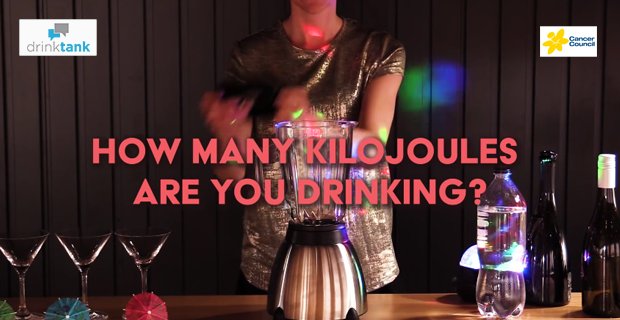Cancer Council Victoria is urging drinkers to beware of the hidden kilojoules in alcoholic beverages, as new figures reveal a few drinks after work could equal half a day’s energy intake.[i]
An analysis of popular alcoholic drinks by Cancer Council Victoria has found that some drinks exceed 1,000kJs each – that’s similar to a slice of takeaway pizza or a Mars Bar.
Now many people don’t realise that alcohol is high in kilojoules and can lead to weight gain.
And excessive consumption of alcohol, and being overweight or obese, are both factors that may increase an individual’s risk of cancer.
Just one can of rum and cola or vodka and citrus contains around 1,000kJ– so if you’re having four or more of these on a night out, you’re adding a whopping 4,000kJs to your diet. That’s almost half the daily intake of the average Australian adult.
To put it into perspective, 4,000kJs is the equivalent of eating either 20 chicken nuggets, 12 chocolate Paddle Pop ice-creams, three and a half cheeseburgers or five bowls of Froot Loops with milk.
Most people wouldn’t dream of eating such an excessive amount of junk food, yet many would easily drink the equivalent on a night out.
The Cancer Council Victoria analysis looked at the amount of kilojoules per serve in popular varieties of wine, beer, cider and premix spirits.
While premix spirits and cider were found to be the worst for our waistlines, beer and wine can also add several hundred extra kilojoules to our diets.
A full-strength stubby of beer contains as much as 640kJ, which is around the same amount of kilojoules as a deep fried dim sim. A 500mL bottle of cider meanwhile contains up to 875kJ, which is almost equal to the kilojoules in a traditional cinnamon Krispy Kreme donut.
It’s easy to see how the kilojoules from alcohol can quickly add up over the course of a night, a week or a month.
In fact, drinking just one stubby of beer a day could lead to around five kilograms of weight gain in a year.
Alcohol is high in kilojoules and also increases your risk of cancer. If you choose to drink, consume it occasionally and in small amounts.
We know that in Victoria alone, six in ten adults are drinking at levels that put them at risk of long-term harms.
People who drink more than two standard drinks a day are risking more than just weight gain in the long-term.
There is strong evidence that alcohol is linked to cancer of the mouth, throat, oesophagus, stomach, liver, bowel and female breast.
More than 3,200, or 2.8 per cent, of the cases of cancer in Australia in 2010 were attributed to alcohol consumption[ii] and 3,900 to overweight or obesity.[iii]
Making simple lifestyle changes to reduce alcohol consumption and weight gain will help to prevent cancers attributed to alcohol and obesity.
Our top tips for drinking less
- Be wary of alcoholic beverages marketed as ‘healthier choices’, such as low-carbohydrate beers. Don’t be fooled by sophisticated marketing, it’s the alcohol content that contributes the most kilojoules.
- There is no such thing as a ‘healthy choice’ when it comes to alcohol. All alcohol increases your risk of cancer.
- If you choose to drink, limit alcohol consumption to two standard drinks per day and never drink more than four standards drinks on a single occasion.
- Check the label to see how many standard drinks are in your beverage. A standard drink is less than a typical glass of wine or stubby.
[youtube id=”s6dARlEm55E”]
For more tips and information visit www.cutyourcancerrisk.org.au/kjs-in-alcohol.
About the research: Cancer Council Victoria used the Dan Murphy’s and First Choice Liquor websites to determine the top 10 selling products in the following categories: premix dark spirits, premix light spirits, cider and beer. Cancer Council Victoria contacted the manufacturers of these drinks to request nutritional information. In the cases where the manufacturer did not provide the information, the nutritional data was sourced from the online CalorieKing Australia food database.
i Based on a daily recommended kJ intake of 8,700kJ
ii Cancers in Australia in 2010 attributable to the consumption of alcohol, Aust N Z J Public Health 2015.
iii Cancers in Australia in 2010 attributable to overweight and obesity, Aust N Z J Public Health 2015








2 comments